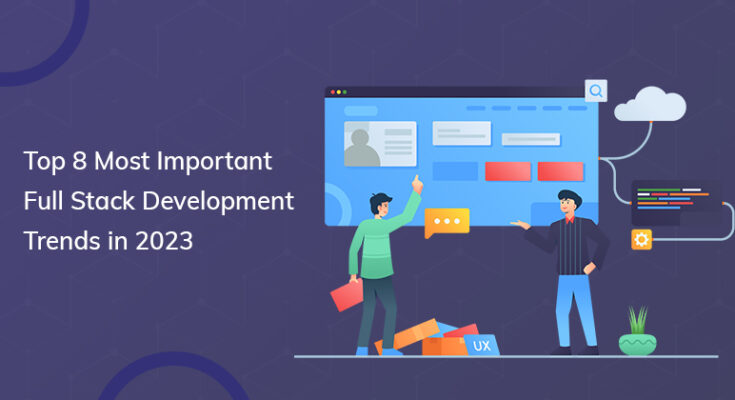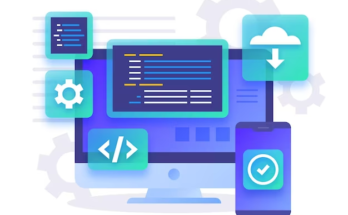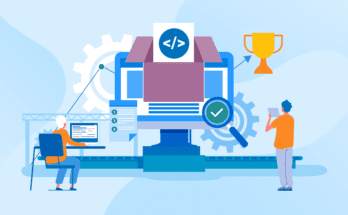In 2023, full-stack development will see critical new products and trends that will change the industry’s work. These trends cover different parts of the development process, such as design, tools, and methods. Full-stack developers are at the center of innovation.
This is true for everything from the rise of progressive web apps (PWAs) and the acceptance of serverless design to the rising popularity of microservices and the merging of artificial intelligence (AI) and machine learning (ML).
The field is also changing because of the rise of low-code and no-code development tools, JavaScript’s continued dominance in full-stack development, and the importance of containerization and Kubernetes.
Last but not least, DevOps and continuous integration/continuous release (CI/CD) techniques are changing how software is built and put into use. This piece looks at the top eight essential trends in full stack development trends for 2023.
The demand for full-stack coders has grown by 35% every year. It shows how new technologies are changing the way things are done.
1. Progressive Web Applications (PWAs)
In 2023, advanced web applications (PWAs) will become a hot topic in full-stack development. Progressive web apps (PWAs) combine the best of both online and mobile app development.
The latest web technologies provide an app-like experience for consumers on any device or platform. PWAs are built to respond quickly, remain stable, and keep users interested by offering features like push notifications and offline access.
One of the primary benefits of PWAs is that they may function across several platforms with a single codebase, cutting down on development and maintenance time and costs. PWAs have been a popular alternative for full-stack developers because they allow them to create cross-platform apps that are quick to load, easy to access, and friendly to users of all devices.
2. Serverless Architecture
The serverless architecture was a hot issue among full-stack engineers in 2023. Thus, it changes the application development paradigm by freeing developers from server and infrastructure administration.
Programmers may focus on designing and releasing new applications in a serverless architecture. The cloud service provider manages the infrastructure, making it scalable, provided, and fault-tolerant.
Teams may quickly experiment and deliver new features without worrying about maintaining the underlying infrastructure. Serverless architecture allows organizations to pay only for the resources they use instead of maintaining and scaling servers.
Serverless design lets full-stack developers build highly scalable and durable systems that can handle shifting workloads and provide a seamless user experience with scalability, flexibility, and reduced operational overhead.
3. Microservices
In 2023, microservices architecture will be the standard for full-stack apps. Decomposing an application into more minor, more manageable services that can be built, deployed, and scaled independently is the goal of this approach.
Full-stack engineers can simultaneously work on many system parts since each microservice is dedicated to a single business function. This strategy fosters modularity, flexibility, and scalability because each microservice may be built and maintained separately.
Microservices allow full-stack developers to improve performance and efficiency by using the technologies, frameworks, and programming languages that are most appropriate for each service. Testing, debugging, and deploying microservices is simpler because modifications to one service do not affect the others.
Microservices also encourage teamwork since engineers may focus on several services at once. By adopting microservices architecture principles, full-stack developers may better respond to changing business needs and provide a more satisfying end-user experience.
4. Artificial Intelligence (AI) and Machine Learning (ML)
In 2023, Artificial Intelligence (AI) and Machine Learning (ML) will be part of full-stack development. These advances are transforming software development and corporate operations.
Full-stack developers are using AI and ML to enhance user experiences. Developers using TensorFlow and PyTorch to build machine learning models may now use them to generate predictions, recommendations, and judgements.
Full-stack developers may streamline workflows, automate procedures, and increase productivity by adding AI and ML to their products. Programming interfaces and software development kits integrate pre-trained models and cognitive services into application development.
AI and ML may be used to construct intelligent chatbots using computer vision, NLP, and sentiment analysis by full-stack engineers. Full-stack developers must stay on top of AI and ML to build smart, cutting-edge applications that meet customers’ evolving expectations.
5. Low-Code/No-Code Development
In 2023, low-code/no-code development will be a significant trend in full-stack development, allowing anyone with less experience with coding to build their apps. These systems enable users to construct applications with little to no coding experience by providing visual interfaces, drag-and-drop tools, and pre-built components.
Full-stack developers are turning to low-code and no-code development platforms to reduce time spent developing and streamline the process. These platforms encourage cooperation between corporate stakeholders and developers when creating new applications.
With low-code/no-code development, full-stack developers may use the platform’s pre-existing capabilities and integrations while focusing on higher-level functionality and personalization.
This movement broadens the pool of people who can contribute to creating new applications. To top it all off, it improves the efficiency of the entire Flutter app development ecosystem by shortening the development cycle and allowing for more frequent revisions.
6. Containerization and Kubernetes
In 2023, containerization and Kubernetes will be heavily used in full-stack development. Containerization enables programs and their dependencies to be bundled into small, movable containers, guaranteeing uniformity across environments and streamlining deployment.
Developers focusing on the whole stack use containerization tools like Docker to build modular, reusable, and easily deployed and maintained application subsystems. But Kubernetes is an impressive container orchestration technology that automatically handles containerised applications’ deployment, scalability, and administration.
It’s a stable and expandable platform for using containers in real-world settings. Using Kubernetes, full-stack developers can easily control the whole container lifecycle, balance loads, and ensure high availability.
Full-stack developers may benefit from containerization and Kubernetes by streamlining their application deployment procedures, lowering dependency concerns, and maximizing resource usage.
These technologies make scalability, fault tolerance, and painless horizontal scaling possible, allowing applications to deal with rising demands efficiently. By using containerization and Kubernetes, full-stack developers may adopt a cloud-native strategy and create durable, scalable, and highly available apps in 2023.
7. Full Stack JavaScript
Full-stack JavaScript dominates full-stack development in 2023. JavaScript and its accompanying tools and packages are utilized front and back. Full-stack developers may construct end-to-end systems using one language.
Full-stack JavaScript authors may transition between client and server sides using server-side frameworks like Node.js and front-end frameworks like React, Angular, or Vue.js. This simplifies code reuse and context switching.
This strategy speeds development, increases front-end-back-end communication, and simplifies app launch and maintenance. Full-stack JavaScript programmers provide quick user interfaces and scalable server-side logic, putting them in demand. Full-stack developers in 2023 will construct dynamic, engaging, fast applications using JavaScript and its tools.
8. DevOps and Continuous Integration/Continuous Deployment (CI/CD)
In 2023, DevOps and CI/CD have matured to the point that they are required for full-stack development. DevOps is a software development method that promotes collaboration and open lines of communication between programmers and server administrators.
Full-stack developers should be deeply familiar with DevOps ideas and techniques to enable seamless integration and delivery of their apps. Developers may automate the integration of code changes, the execution of automated tests, and the deployment of applications to production environments with the help of CI/CD pipelines, an essential aspect of DevOps.
These pipelines guarantee high-quality code, encourage a culture of constant improvement, and shorten the development cycle. Full-stack developers may boost productivity, clear up deployment bottlenecks, and improve teamwork by adopting DevOps and CI/CD.
They can provide stable, reliable upgrades to their apps regularly without disrupting the user experience. In 2023, full-stack developers that care about delivering high-quality, scalable, and fast deployable apps must use DevOps and CI/CD.
Also Read: Important Trends In Mobile Application Development In 2023
Conclusion
In 2023, full-stack development will see several groundbreaking innovations and industry-altering changes. Significant results to monitor include serverless architecture, microservices, AI/ML integration, low-code/no-code development, containerization, full-stack JavaScript, and DevOps/CI/CD. Full-stack developers may stay at the cutting edge of the rapidly growing field of software development by following these trends and obtaining the relevant skills.




